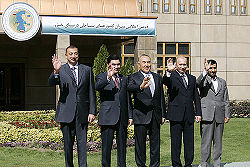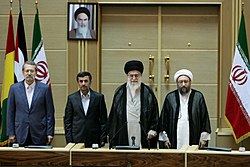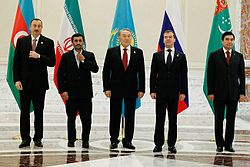Mahmoud Ahmadinejad
Mahmoud Ahmadinejad, also written Ahmadinezhad (Persian: مَحْمُودُ احْمَدَینَژادْ; born October 28, 1956) is an Iranian politician who was the sixth President of the Islamic Republic of Iran. He was president from August 3, 2005 to August 3, 2013.
Mahmoud Ahmadinejad | |||||||||||||||||||||||||
|---|---|---|---|---|---|---|---|---|---|---|---|---|---|---|---|---|---|---|---|---|---|---|---|---|---|
 Ahmadinejad in March 2019 | |||||||||||||||||||||||||
| 6th President of Iran | |||||||||||||||||||||||||
| In office 3 August 2005 – 3 August 2013 | |||||||||||||||||||||||||
| Supreme Leader | Ali Khamenei | ||||||||||||||||||||||||
| First Vice President | Parviz Davoodi Esfandiar Rahim Mashaei Mohammad Reza Rahimi | ||||||||||||||||||||||||
| Preceded by | Mohammad Khatami | ||||||||||||||||||||||||
| Succeeded by | Hassan Rouhani | ||||||||||||||||||||||||
| Mayor of Tehran | |||||||||||||||||||||||||
| In office 3 May 2003 – 28 June 2005 | |||||||||||||||||||||||||
| Preceded by | Mohammad-Hossein Moghimi (Acting) | ||||||||||||||||||||||||
| Succeeded by | Ali Saeedlou (Acting) | ||||||||||||||||||||||||
| Governor of Ardabil Province | |||||||||||||||||||||||||
| In office 28 November 1993 – 29 October 1997 | |||||||||||||||||||||||||
| President | Akbar Hashemi Rafsanjani | ||||||||||||||||||||||||
| Preceded by | Province created | ||||||||||||||||||||||||
| Succeeded by | Seyyed Hamid Tahayi | ||||||||||||||||||||||||
| Secretary General of the Non-Aligned Movement | |||||||||||||||||||||||||
| In office 30 August 2012 – 3 August 2013 | |||||||||||||||||||||||||
| Preceded by | Mohamed Morsi | ||||||||||||||||||||||||
| Succeeded by | Hassan Rouhani | ||||||||||||||||||||||||
| |||||||||||||||||||||||||
| Personal details | |||||||||||||||||||||||||
| Born | Mahmoud Sabbaghian[3] 28 October 1956 (aged 69) Aradan, Semnan, Imperial State of Iran | ||||||||||||||||||||||||
| Political party |
| ||||||||||||||||||||||||
| Spouse(s) | Azam Farahi (1980–present) | ||||||||||||||||||||||||
| Children | 3 | ||||||||||||||||||||||||
| Relatives |
| ||||||||||||||||||||||||
| Residence | Square 72, Narmak, Tehran, Iran[4] | ||||||||||||||||||||||||
| Alma mater | Iran University of Science and Technology | ||||||||||||||||||||||||
| Occupation | University professor | ||||||||||||||||||||||||
| Profession | Traffic engineer | ||||||||||||||||||||||||
| Signature | |||||||||||||||||||||||||
| Website | Personal Twitter | ||||||||||||||||||||||||
| Military service | |||||||||||||||||||||||||
| Allegiance | |||||||||||||||||||||||||
| Branch/service | Revolutionary Guards | ||||||||||||||||||||||||
| Years of service | 1986–1988[5][6] | ||||||||||||||||||||||||
| Rank | None[a] | ||||||||||||||||||||||||
| Unit | Hamzeh Headquarters[5] | ||||||||||||||||||||||||
| Commands | Combat engineering Unit, 6th Special Division[6] | ||||||||||||||||||||||||
| Battles/wars | Iran–Iraq War | ||||||||||||||||||||||||
Ahmadinejad became the mayor of Tehran, the capital of Iran, on May 3, 2003. He was chosen to be the president in elections on June 24, 2005. Many people think he is very religious. Because of that, the religious leadership in Iran supported him in many ways when he was elected.
Ahmadinajad's political power comes from the Alliance of Builders of Islamic Iran, also known as "Abadgaran". This is an alliance between Islamic parties and organizations.
Mahmoud Ahmadinejad has a Master of Science in Civil engineering from the Iran University of Science and Techology. He also has a PhD in transportation engineering from the same university. Hassan Rouhani was elected on June 15, 2013 as Ahmadinejad's successor and took office on August 3, 2013. Ahmadinejad registered for office again on June 2, 2024.[8][9][10] He however was denied from re-election by the council.[11][12]
His brother was failed presidential candidate and staff member Davoud Ahmadinejad (1950–2017).
Mahmoud Ahmadinejad Media
Ahmadinejad at the United Nations Conference on Sustainable Development in 2012
Ahmadinejad speaking at Columbia University, September 2007
Participants of the second Caspian Summit in October 2007. From left to right: President of Azerbaijan Ilham Aliev, President of Turkmenistan Gurbanguly Berdimuhamedow, President of Kazakhstan Nursultan Nazarbaev, President of Russia Vladimir Putin and President of Iran Mahmoud Ahmadinejad.
Ahmadinejad speaking in the Majlis, Chairman Ali Larijani is also pictured
Ahmadinejad with Ali Khamenei, Ali Larijani and Sadeq Larijani in 2011
Ahmadinejad with leaders of the Caspian sea bordering nations
References
- ↑ Smith, Matt (16 May 2011). "Ahmadinejad losing ground in Iran power struggle, analysts say". CNN. Retrieved 3 June 2016.
- ↑ Milani, Abbas (3 August 2009). "Inside The Civil War That's Threatening The Iranian Regime". The New Republic. https://newrepublic.com/article/407/inside-the-civil-war-thats-threatening-the-iranian-regime. Retrieved 3 June 2016.
- ↑ داستان داوود و محمود: داوود احمدینژاد چرا عليه محمود احمدینژاد سخنرانی میكند؟ [The Story of Davoud and Mahmoud: Why Davoud Ahmadinejad Speaks Against Mahmoud Ahmadinejad?]. Aseman Weekly (in Persian) (7). 19 November 2011. Archived from the original on 20 August 2013. Retrieved 11 July 2016.
{{cite journal}}: CS1 maint: unrecognized language (link) - ↑ Lucas, Scott (5 January 2015). "Iran Feature: Signs of an Ahmadinejad Comeback & a Hard-Line Challenge to Speaker of Parliament Larijani". EA WorldView. Retrieved 3 June 2016.
- ↑ 5.0 5.1 Peterson, Scott (2010). Let the Swords Encircle Me: Iran: A Journey Behind the Headlines. Simon and Schuster. pp. 279–280. ISBN 978-1416597391.
- ↑ 6.0 6.1 Ehteshami, Anoushiravan; Zweiri, Mahjoob (2007), Iran and the Rise of Its Neoconservatives: The Politics of Tehran's Silent Revolution, I.B.Tauris, p. 55, ISBN 978-0857713674
- ↑ Afshon Ostovar (2016). Vanguard of the Imam: Religion, Politics, and Iran's Revolutionary Guards. Oxford University Press. pp. 124. ISBN 978-0190491703.
- ↑ Nicholls, Catherine (2024-06-02). "Iran's ex-President Ahmadinejad to run in presidential election, state TV says". CNN. Retrieved 2024-06-03.
- ↑ Motamedi, Maziar. "Iran's ex-president Ahmadinejad, disqualified Larijani sign up for election". Al Jazeera. Retrieved 2024-06-03.
- ↑ "چرا احمدینژاد علیرغم علم به ردصلاحیت ثبتنام کرد؟ - تسنیم". خبرگزاری تسنیم | Tasnim (in فارسی). Retrieved 2024-06-03.
- ↑ "Iran OKs 6 candidates for presidential race, but again blocks Ahmadinejad". AP News. 2024-06-09. Retrieved 2024-06-25.
- ↑ "Iran approves 6 candidates for presidential race, but again bars former President Ahmadinejad". PBS News. 2024-06-09. Retrieved 2024-06-25.









